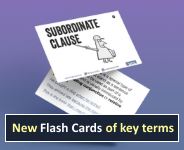A clause which is subordinate to some other part of the same sentence is a subordinate clause; for example, in The apple that I ate was sour, the clause that I ate is subordinate to apple (which it modifies).
- That’s the street where Ben lives. [relative clause; modifies street]
- He watched her as she disappeared. [Adverbial; modifies watched]
- What you said was very nice. [acts as Subject of was]
- She noticed an hour had passed. [acts as Object of noticed]
Subordinate clauses contrast with coordinate clauses as in It was sour but looked very tasty. (Contrast: main clause)
However, clauses that are directly quoted as direct speech are not subordinate clauses.
- Not subordinate: He shouted, “Look out!”
A subordinate clause does not function as a sentence on its own but functions instead as part of a larger clause. For example, in the sentence I believe that we will have a hot summer the clause that we will have a hot summer is a subordinate clause functioning as part of the larger main clause: it is the Direct Object of the verb believe.

